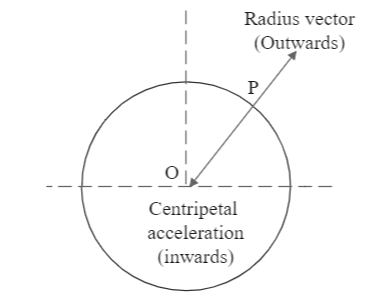
What is the angle between the radius vector and the centripetal acceleration?
(A) $ \dfrac{\pi }{2} $
(B) $ 2\pi $
(C) $ \dfrac{{3\pi }}{2} $
(D) $ \pi $
Answer
567.6k+ views
Hint
Centripetal acceleration acts on a body moving in a circular path. It acts towards the centre of the body. The angle between this acceleration and the radius vector can be found by understanding their directions.
Complete step by step answer
Centripetal is similar to ‘central-seeking’. A force that is responsible for generating circular motion in a body is called centripetal force. As we know that force is calculated as the product of mass and acceleration that a body is going through, the acceleration produced by centripetal force is consequently, termed as centripetal acceleration. Since mass is directionless but force is a vector quantity, the direction of the centripetal acceleration is the same as the direction of the force i.e. towards the centre.
In a circular motion, the radius vector points towards the circumference of the motion. It starts from the centre and ends outwards on the surface of the circle.

We can see that the centripetal acceleration acts towards the centre O, while the radius vector acts outwards from the centre towards point P. This implies that these two quantities have exactly opposite directions of operation. Hence, the angle between them is equal to $ \pi $ .
Option (D) is the correct answer.
Note
Centripetal acceleration can be observed with a simple experiment. Take a ball and tie a long thread around it. When you start swinging it using one end of the thread above your head or in front of your body, try to make circular motion. The system constantly moves in a circular path with the help of force provided by you. But the ball does not fall off because of the centripetal acceleration that acts inwards and keeps the system stable.
Centripetal acceleration acts on a body moving in a circular path. It acts towards the centre of the body. The angle between this acceleration and the radius vector can be found by understanding their directions.
Complete step by step answer
Centripetal is similar to ‘central-seeking’. A force that is responsible for generating circular motion in a body is called centripetal force. As we know that force is calculated as the product of mass and acceleration that a body is going through, the acceleration produced by centripetal force is consequently, termed as centripetal acceleration. Since mass is directionless but force is a vector quantity, the direction of the centripetal acceleration is the same as the direction of the force i.e. towards the centre.
In a circular motion, the radius vector points towards the circumference of the motion. It starts from the centre and ends outwards on the surface of the circle.

We can see that the centripetal acceleration acts towards the centre O, while the radius vector acts outwards from the centre towards point P. This implies that these two quantities have exactly opposite directions of operation. Hence, the angle between them is equal to $ \pi $ .
Note
Centripetal acceleration can be observed with a simple experiment. Take a ball and tie a long thread around it. When you start swinging it using one end of the thread above your head or in front of your body, try to make circular motion. The system constantly moves in a circular path with the help of force provided by you. But the ball does not fall off because of the centripetal acceleration that acts inwards and keeps the system stable.
Recently Updated Pages
Master Class 12 Economics: Engaging Questions & Answers for Success

Master Class 12 Maths: Engaging Questions & Answers for Success

Master Class 12 Biology: Engaging Questions & Answers for Success

Master Class 12 Physics: Engaging Questions & Answers for Success

Master Class 8 Maths: Engaging Questions & Answers for Success

Class 8 Question and Answer - Your Ultimate Solutions Guide

Trending doubts
What is meant by exothermic and endothermic reactions class 11 chemistry CBSE

10 examples of friction in our daily life

One Metric ton is equal to kg A 10000 B 1000 C 100 class 11 physics CBSE

1 Quintal is equal to a 110 kg b 10 kg c 100kg d 1000 class 11 physics CBSE

Difference Between Prokaryotic Cells and Eukaryotic Cells

What are Quantum numbers Explain the quantum number class 11 chemistry CBSE




